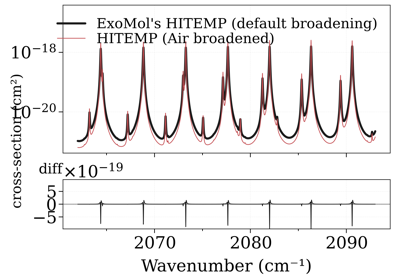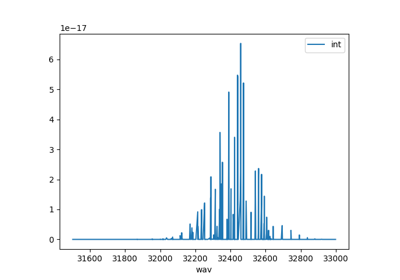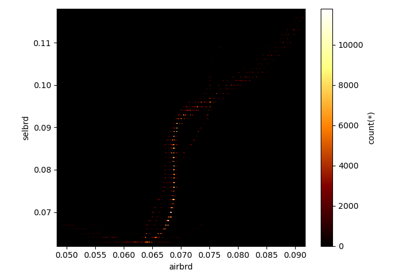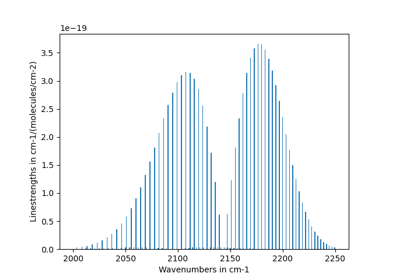radis.io.hitemp module¶
Created on Tue Jan 26 22:40:51 2021
@author: erwan
https://stackoverflow.com/questions/55610891/numpy-load-from-io-bytesio-stream https://stupidpythonideas.blogspot.com/2014/07/three-ways-to-read-files.html
- class HITEMPDatabaseManager(name, molecule, local_databases, engine='default', verbose=True, chunksize=100000, parallel=True)[source]¶
Bases:
DatabaseManager- keep_only_relevant(inputfiles, wavenum_min=None, wavenum_max=None) list[source]¶
For CO2 and H2O, return only relevant files for given wavenumber range.
If other molecule, return the file anyway. see
radis.io.hitemp.keep_only_relevant()
- parse_to_local_file(opener, urlname, local_file, pbar_active=True, pbar_t0=0, pbar_Ntot_estimate_factor=None, pbar_Nlines_already=0, pbar_last=True)[source]¶
Uncompress
urlnameintolocal_file. Also add metadata- Parameters
opener (an opener with an .open() command)
gfile (file handler. Filename: for info)
- fetch_hitemp(molecule, local_databases=None, databank_name='HITEMP-{molecule}', isotope=None, load_wavenum_min=None, load_wavenum_max=None, columns=None, cache=True, verbose=True, chunksize=100000, clean_cache_files=True, return_local_path=False, engine='default', output='pandas', parallel=True)[source]¶
Stream HITEMP file from HITRAN website. Unzip and build a HDF5 file directly.
Returns a Pandas DataFrame containing all lines.
- Parameters
molecule (
"H2O", "CO2", "N2O", "CO", "CH4", "NO", "NO2", "OH") – HITEMP molecule. See https://hitran.org/hitemp/local_databases (str) – where to create the RADIS HDF5 files. Default
"~/.radisdb/hitemp". Can be changed inradis.config["DEFAULT_DOWNLOAD_PATH"]or in ~/radis.json config filedatabank_name (str) – name of the databank in RADIS Configuration file Default
"HITEMP-{molecule}"isotope (str, int or None) – load only certain isotopes :
'2','1,2', etc. IfNone, loads everything. DefaultNone.load_wavenum_min, load_wavenum_max (float (cm-1)) – load only specific wavenumbers.
columns (list of str) – list of columns to load. If
None, returns all columns in the file.
- Other Parameters
cache (
True,False,'regen'or'force') – ifTrue, use existing HDF5 file. IfFalseor'regen', rebuild it. If'force', raise an error if cache file cannot be used (useful for debugging). DefaultTrue.verbose (bool)
chunksize (int) – number of lines to process at a same time. Higher is usually faster but can create Memory problems and keep the user uninformed of the progress.
clean_cache_files (bool) – if
Trueclean downloaded cache files after HDF5 are created.return_local_path (bool) – if
True, also returns the path of the local database file.engine (‘pytables’, ‘vaex’, ‘default’) – which HDF5 library to use to parse local files. If ‘default’ use the value from ~/radis.json
output (‘pandas’, ‘vaex’, ‘jax’) – format of the output DataFrame. If
'jax', returns a dictionary of jax arrays. If'vaex', output is avaex.dataframe.DataFrameLocalNote
Vaex DataFrames are memory-mapped. They do not take any space in RAM and are extremelly useful to deal with the largest databases.
parallel (bool) – if
True, uses joblib.parallel to load database with multiple processes
- Returns
df (pd.DataFrame) – Line list A HDF5 file is also created in
local_databasesand referenced in the RADIS config file with namedatabank_namelocal_path (str) – path of local database file if
return_local_path
Examples
from radis import fetch_hitemp df = fetch_hitemp("CO") print(df.columns) >>> Index(['id', 'iso', 'wav', 'int', 'A', 'airbrd', 'selbrd', 'El', 'Tdpair', 'Pshft', 'ierr', 'iref', 'lmix', 'gp', 'gpp', 'Fu', 'branch', 'jl', 'syml', 'Fl', 'vu', 'vl'], dtype='object')

Compare CO xsections from the ExoMol and HITEMP database
Compare CO xsections from the ExoMol and HITEMP databaseNotes
if using
load_only_wavenum_above/beloworisotope, the whole database is anyway downloaded and uncompressed tolocal_databasesfast access .HDF5 files (which will take a long time on first call). Only the expected wavenumber range & isotopes are returned. The .HFD5 parsing useshdf2df()See also
fetch_hitran(),fetch_exomol(),fetch_geisa(),hdf2df(),fetch_databank()
- keep_only_relevant(inputfiles, wavenum_min=None, wavenum_max=None) Union[list, float][source]¶
Parser file names for
wavenum_format(min and max) and only keep relevant files if the requested range is[wavenum_min, wavenum_max]- Returns
relevant (list of relevant files)
files_wmin, files_wmax ((float, float) : wavenum min & max of relevant range)






